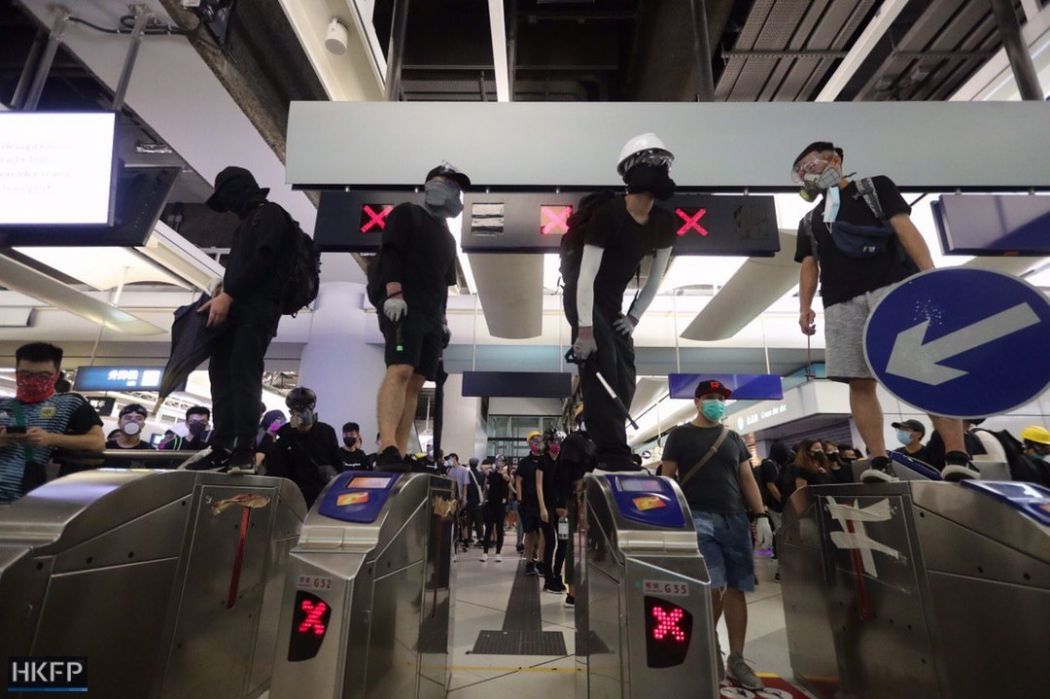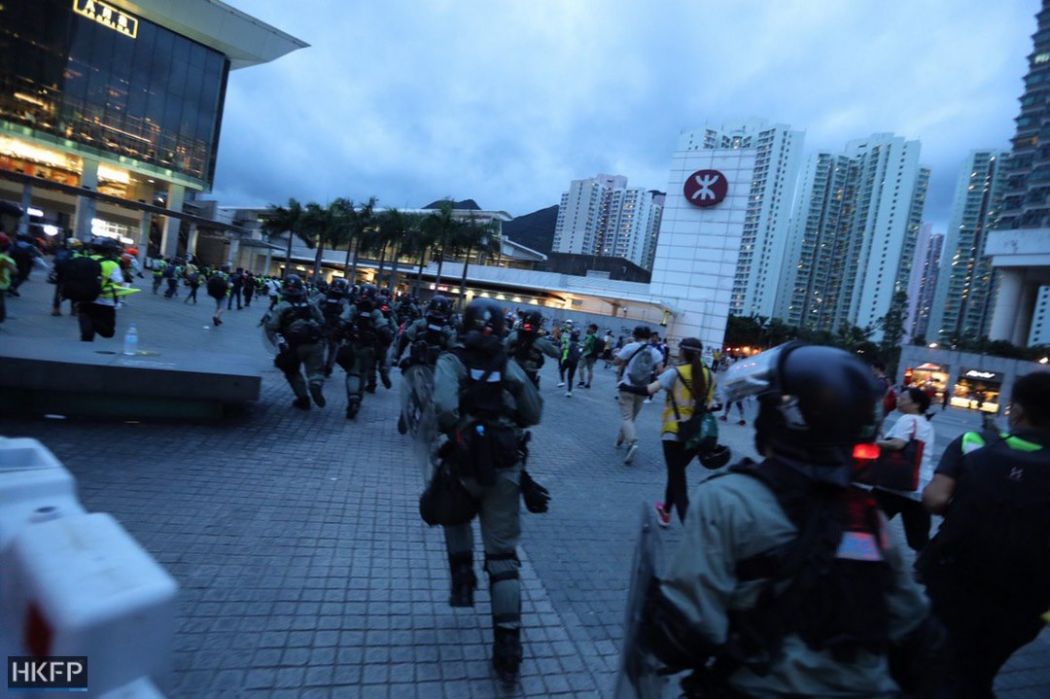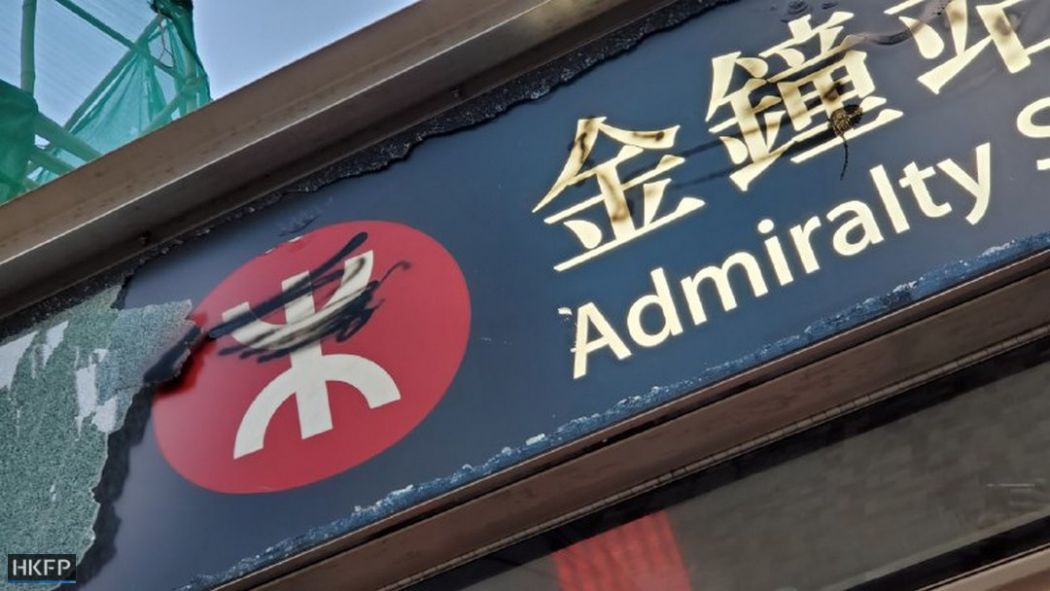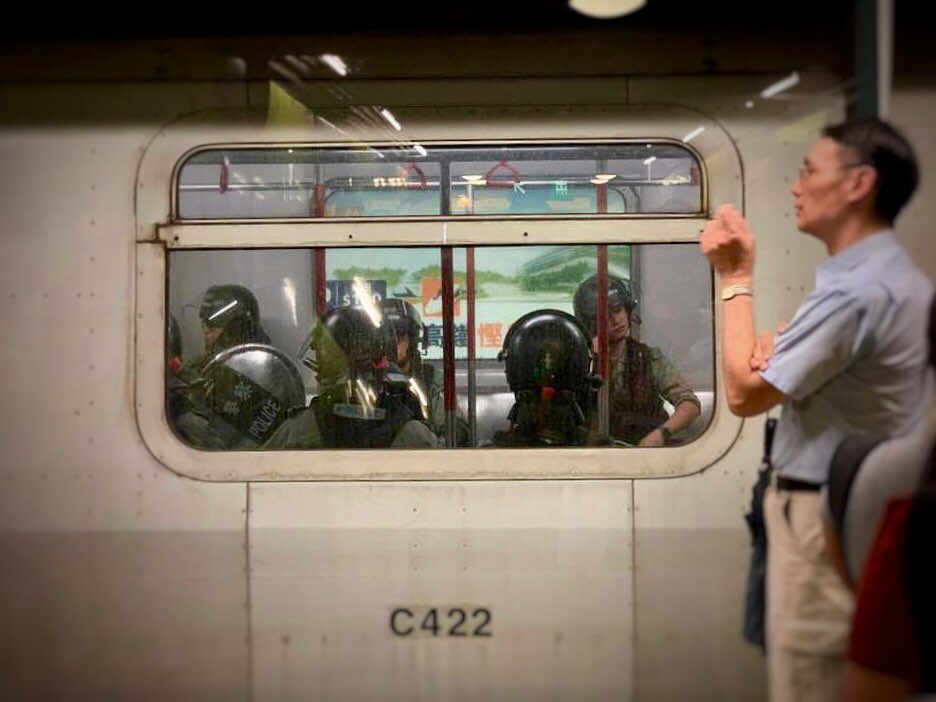Hong Kong’s metro system has long been lauded for its world-class efficiency, affordability and enviable safety record.
In the early days of the city’s summer of dissent, sparked by an ill-fated extradition bill, demonstrators would form long, snaking queues for MTR ticket machines and even leave cash for others to buy single journey tickets to avoid having their trips traced on their Octopus cards. Five days after police fired tear gas inside Kwai Fong MTR station on August 11, choking it with smoke, members of the public turned up with washcloths to wipe down soiled surfaces.

Now, 16 weeks on from the start of the movement, battered turnstiles and shattered windows have become the norm—with protesters adopting the term “The Chinese Communist Party’s (CCP) railway” (dong tit), a play on the MTR’s Chinese name (gong tit), meaning “Hong Kong’s railway.” Dozens of stations have been vandalised with demonstrators started fires at a Wan Chai MTR station exit last Sunday, while others piled on rubbish by the entrance after police closed off inside access.
HKFP takes a look at how the embattled rail giant fell out of favour with Hongkongers.
Existing grievances
Before the current political crisis, the MTR Corporation (MTRC) was already embroiled in multiple scandals. The operator’s handling of the Hung Hom station expansion project—part of an HK$97.1 billion Shatin to Central Link—came under scrutiny when, last June, it was revealed that in 2015 workers had cut steel bars, instead of correctly screwing them into couplers.
A subsequent investigation found multiple examples of shoddy work, missing records, cost overruns and delays. In March, two MTR trains collided at Central station, leaving two drivers hospitalised. The incident occurred during a test run for a new HK$3.3 billion signalling system, further rattling public trust in the transport provider.
As recently as Tuesday, a Hung Hom-bound train derailed, injuring eight. MTR officials said at least four cracks on the rail were found—echoing past corner-cutting controversies—though some or all of them may have been a result, not a cause, of the crash.

Hong Kong’s government is also the largest shareholder of the MTRC with 75.28 per cent of its shares as of August 31, according to the rail operator. But authorities have come under fire for failing to step in over rising fares, which are adjusted according to the inflation rate despite most of the MTRC’s profits coming from property management, not train services.
These existing grievances laid the groundwork for inflamed tensions between the public and the MTRC during the protest movement.
Mob attack
On July 21 at around 10:55pm, a Tuen Mun-bound train ground to a halt at Yuen Long MTR station. Its driver had reportedly made several attempts to close the doors but, when she found herself unable to, asked all passengers to alight.
A few metres away on the concourse below, a group armed with bamboo sticks had launched a bloody attack on commuters and residents, apparently targeting black-clad anti-extradition law protesters returning from Hong Kong Island. Moments later, at around 11:06pm, the mob stormed the carriages, indiscriminately lashing out at passengers, leaving dozens bloodied and bruised.

The incident marked one of the most violent episodes in recent months, but it also turned public attention towards the MTRC, as critics accused the company of failing to keep passengers safe.
The corporation defended the driver’s decision to make passengers alight, saying that, at the time, there was no outbreak of violence on the platform.
‘Accomplice to rioters’
A month later, in a sit-in to mark the anniversary of the mob attack, dramatic clashes broke out again in Yuen Long MTR station. As the day wore on, baton-wielding riot police moved in to clear protesters, who set off fire extinguishers in return before making a quick escape on the train.

But it was not the first time protesters had used the MTR to flee advancing officers—on July 14, after ugly clashes broke out in Sha Tin’s glitzy New Town Plaza, many protesters took off by jumping the turnstiles at the connecting train station.
Some even lodged themselves between train doors until all escapees had boarded after it was announced that no more trains would stop at Sha Tin MTR station.
Belatedly posting videos. At 10:30pm after MTR announced trains wouldn’t stop at Sha Tin station, protesters forced the doors to stay open so that people running away from the mall could still catch it. MTR staff said there would be more trains but people didn’t believe them. pic.twitter.com/NoXIVJcEed
— Elaine Yu (@yuenok) July 14, 2019
But the getaway in August prompted the wrath of Chinese state media, with the CCP mouthpiece People’s Daily the next day accusing the corporation of “conspiring with rioters” by allegedly organising additional trains to help protesters to leave Yuen Long.
“What is most intriguing is that the MTRC not only delayed in calling the police, it even arranged special trains for rioters to escape for free,” read the article. “This really is a puzzling scene. Those dressed in black have broken the law and disrupted social order, but can receive such preferential treatment. What is wrong with the MTRC?”

Similarly, state-run news agency Xinhua shared a video that day claiming the transit firm was laying on “exclusive,” free services for violent protesters, and questioned whether it was an “accomplice of rioters.”
Hours later, the embattled rail giant declared its plan to close stations “[i]f fights, vandalism or other acts of violence occur, under emergency situation[s], operation and train service at the stations concerned may be immediately stopped, and/or the station will be closed, without prior notice,” prompting allegations that it had kowtowed to Chinese pressure.
Halted services
In keeping with their word, the rail operator made the unprecedented decision to seal off Lam Tin, Kwun Tong, Ngau Tau Kok and Kowloon Bay MTR stations on August 24 “as a prudent measure,” ahead of an authorised march against smart lampposts and other grievances.
MTR operates exclusive train for violent protesters in Hong Kong, and free of charge pic.twitter.com/SyjMQCRRCT
— China Xinhua News (@XHNews) August 22, 2019
The move prompted organiser Ventus Lau to blast the transport provider as inconveniencing residents and commuters: “I strongly condemn the MTR for impeding the public from attending a lawful protest, and affecting regular civilians going to work in East Kowloon,” he said.
After police-protester clashes broke out in that part of the New Territories, many found themselves stranded. But eagle-eyed commuters spotted police taking a train from Choi Hung in the direction of Kowloon Bay, despite the closure of four MTR stations in the vicinity earlier—a move which drew the ire of critics who accused the operator of preferential treatment.
The corporation told RTHK that it had called the police after seeing that the gates to Kowloon Bay station had been vandalised. “The police were arranged to take the train to deal with the situation in Kowloon Bay because the traffic conditions at road-level were not suitable,” it said.
As protester anger against the MTRC grew, a court on August 30 granted the corporation an injunction which prevents “unlawful and wilful acts on the railway.” The order was an attempt to prevent protesters from besieging and vandalising its stations. But in the weeks that followed, it did little to deter them.
‘The CCP’s railway’
The MTRC was plunged into another controversy on August 31 when, after a long night of police-protester cat and mouse games, elite officers charged into train carriages at Prince Edward MTR station, beating and pepper-spraying those inside. Fifty-three people were arrested, as journalists and medical workers were ushered out of the facility.

In the days that followed, rumours of deaths abounded online as netizens seized on an alleged discrepancy in the number of injuries reported by paramedics. An initial report at around midnight reported 10 injured people; the figure was adjusted about 45 minutes later to just seven.
The MTRC found itself the target of a backlash as members of the public demanded the release of CCTV video of the night in question. It released surveillance screenshots September 10 of the night in question in an attempt to dispel rumours, but to no avail, as many continued to demand access to the full tapes. The corporation refused, citing privacy concerns—a decision which fuelled further public anger and legal action from a student union head who was arrested that night.

On September 1, trains to Lantau’s Chek Lap Kok island and along the Tung Chung Line were suspended as protesters formed roadblocks to stymie traffic around the airport as part of a transport “stress test.” With transport connections severed, thousands were forced to set off on foot for hours, blocking vehicles behind them as they left the airport.
Before embarking on the long walk back to the city, protesters vented their growing frustrations with the “CCP’s railway” by trashing Tung Chung MTR station, flooding the interior and laying waste to ticketing machine screens.
Meanwhile, videos began to circulate online showing people how to jump both real and simulated MTR turnstiles, as a quick escape and to avoid buying tickets or using travel cards.
‘Treasure and safeguard’
In an open letter on September 8, MTRC Chairman Rex Auyeung Pak-Kuen and CEO Dr Jacob Kam Chak-pui condemned what they described as malicious attacks against stations, saying: “At this crucial moment, we wish all sectors of the community could treasure and safeguard this railway network which has been carrying our collective memories over the past few decades. Please allow us to honour our commitment and continue to provide our fellow citizens with safe and reliable railway service.”
12:11 Some students set up an MTR turnstile model with barricades and practise jumping over it as an act to stop paying for MTR ticket fares. pic.twitter.com/W7V6O4dLop
— Varsity CUHK (@varsitycuhk) September 9, 2019
But the appeal did little to soothe the anger and, hours later, protesters took aim at Central MTR station—smashing glass panels and building blazes at its entrances.
In a rare public appearance, Chief Executive Carrie Lam, along with Transport Secretary Frank Chan, took a tour of Central MTR station on September 9 to inspect the damage, though her concern for a battered turnstile further enraged demonstrators, who said she had yet to visit any injured protesters in hospital.
The government has repeatedly condemned those responsible for acts of vandalism as “radical protesters.”

The metro operator announced on September 12 that it would not run overnight trains during the Mid-Autumn Festival in light of the “recent situation,” departing from past practices. The decision was made after having “conducted a risk assessment with relevant government departments in the light of the recent situation,” it said.
After an extended day of clashes on September 15, which saw protesters throwing bricks at police and volleys of tear gas shot in return, officers retreated into MTR stations across the Island Line, using the facilities for respite and as a staging ground—fuelling anger towards the corporation for cooperating with the force.

As anger towards the MTRC mounts and its stations increasingly become protest flashpoints, the future of the public’s derailed relationship with the transport provider heads in an uncertain direction. Whether grievances are political or simply a result of the inconvenience caused by cutting off swathes of the city during protests, a long journey lies ahead for Hong Kong’s war-weary railway.
Hong Kong Free Press relies on direct reader support. Help safeguard independent journalism and press freedom as we invest more in freelancers, overtime, safety gear & insurance during this summer’s protests. 10 ways to support us.

